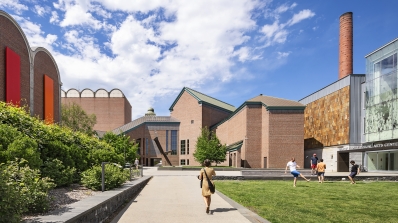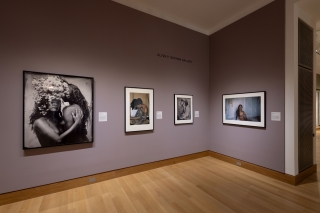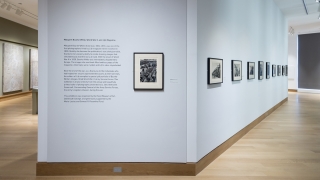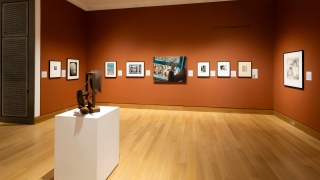Exhibitions Archive
Images of Violence, 1500–1900
Recording WarLegacies of Queer Indigenous Liberation
Love as CeremonyLove as Ceremony: Legacies of Two-Spirit Liberation highlights the work of contemporary North American “Two-Spirit” artists, exploring the ways in which two-spirit communities reclaim ancestral knowledge and imagine possible futures. The exhibition focuses on expressions of joy, love, and liberation in an effort to both resist and dispel Western colonial characterizations of queerness which have historically perpetuated narratives of taboo and voyeurism.
A Space for Dialogue is a student-curated exhibition program that began in 2001. Hood Museum of Art interns create an installation drawn from the museum's permanent collection by engaging with every aspect of curation, from doing research and selecting objects, to choosing frames and a wall color, to planning a layout and writing labels and a brochure, to giving a public talk. There have been over 100 A Space for Dialogue exhibitions on a wide variety of themes.
Margaret Bourke-White (American, 1904–1971) was one of the first photographers that Life magazine sent to Europe to cover World War II. The images she sent back filled endless pages of the magazine; Americans were riveted; and sales skyrocketed. This exhibition is drawn entirely from a unique portfolio of her photographs created near the end of the war.
Margaret Bourke-White in the USSR, 1930-32
"The Land of Tantalizing Mystery"
Fortune magazine photographer Margaret Bourke-White often managed to garner attention for herself as much as for her work. Her Russia portfolio, excerpted here, was no exception, primarily because she was the first outside photojournalist allowed into the Soviet Union during the first Five Year Plan (1928–1932). Over three consecutive trips, she produced images of factories and other infrastructure projects that had been kept secret. To get these pictures, she convinced a series of Soviet bureaucrats that she could help the country gain international recognition for their achievements through her photographs.
Prior to her first trip she had heard about the great privations the people were enduring and she travelled with a trunk of canned food. Everywhere she went, the construction was awe-inspiring, but the plight of the workers was hard to ignore. In 1930, she described the situation cryptically, “Little food; No shoes; Terrible inefficiency; Steady progress; Great hope.” On her subsequent visits, she moved beyond the machine-age subjects that had defined her career and began to focus on Russian people’s lives. The twelve photogravures featured here are part of the special portfolio she published in 1934 with Argus press.
Windows in Art
On ViewOn View, a thematic exploration of windows in art, is organized around three central themes: a view into the private world, a view into the public world, and the abstraction of the window itself. Featuring works by twentieth and twenty-first century American artists, the exhibition invites you not only to consider what lies beyond the window, but also how its framing influences our perception.
A Space for Dialogue is a student-curated exhibition program that began in 2001. Hood Museum of Art interns create an installation drawn from the museum's permanent collection by engaging with every aspect of curation, from doing research and selecting objects, to choosing frames and a wall color, to planning a layout and writing labels and a brochure, to giving a public talk. There have been over 100 A Space for Dialogue exhibitions on a wide variety of themes.



